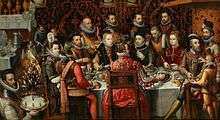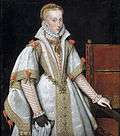Anna of Austria, Queen of Spain
| Anna of Austria | |
|---|---|
 Anna of Austria by Sofonisba Anguissola | |
| Queen consort of Spain | |
| Tenure | 1570–1580 |
| Born |
2 November 1549 Cigales, Spain |
| Died |
26 October 1580 (aged 30) Badajoz, Spain |
| Burial | El Escorial |
| Spouse | Philip II of Spain |
| Issue Detail |
Ferdinand, Prince of Asturias Diego, Prince of Asturias Philip III of Spain |
| House | Habsburg |
| Father | Maximilian II, Holy Roman Emperor |
| Mother | Maria of Spain |
| Religion | Roman Catholicism |
Anna of Austria (1 November 1549 – 26 October 1580) was Queen of Spain by virtue of her marriage to her uncle, King Philip II of Spain.
Family
She was the eldest daughter of Holy Roman Emperor Maximilian II, and Maria of Spain. Her maternal grandparents were Charles V, Holy Roman Emperor who was emperor when she was born, and Isabella of Portugal. Her paternal grandparents were Holy Roman Emperor Ferdinand I, and Anna of Bohemia and Hungary. Interesting note; Charles V and Ferdinand I were brothers. Anna was born in Spain, but lived in Vienna from the age of four. She had many siblings, two of whom became emperors (Rudolf II and Matthias). Among her sisters was Queen Elisabeth of France, wife of King Charles IX of France.
Biography
%2C_Queen_Consort_of_Spain.svg.png)
Anna was considered her father's favorite child. The story goes that he enjoyed playing and gambling with her and once a meeting of the Estates of Hungary was postponed because Anna was sick. She received a Catholic education even though her father was sympathetic to Lutheranism.
Marriage
As the eldest daughter of the Holy Roman Emperor, Anna was a desirable candidate for marriage at the European courts. Her parents thought of a Spanish marriage to strengthen links between the Austrian and Spanish Habsburg families. Initially she had her cousin Don Carlos of Spain in mind, the only son of her maternal uncle Philip II of Spain. These plans were shattered in 1568 when Don Carlos died. Plans for a Spanish marriage were revived when Philip's third wife, Elisabeth, died in childbirth, also in 1568. As a result, Philip was left a widower with two young daughters. Philip had been married three times before: first to his double first cousin Maria Manuela, Princess of Portugal, secondly to his first cousin, once removed Mary I of England, and thirdly to the aforementioned Elisabeth of Valois. Philip was now looking for his fourth wife, since he had no male heir since Don Carlos died. In February 1569, Anna's engagement to her uncle Philip II was announced and in May 1570 they married by proxy.
Anna traveled from Austria to Spain in the autumn of 1570 accompanied by her brothers Albert and Wenzel. They traveled through the Netherlands, where Anna was accosted by friends and relatives of Floris of Montigny, the younger brother of the executed Count of Horn. Montigny had been imprisoned in Spain since 1567. Now that King Philip had entered into a new marriage, Montigny's family and friends dared to hope for leniency. They received a promise from the future queen that she would do her utmost to free Montigny; however she was unsuccessful, with Montigny being strangled on the orders of the king.
Anna passed along the English Channel, where Elizabeth I sent her admirals, Charles Howard and William Wynter, to offer support and safe passage.[1]
On 3 October Anna arrived on Spanish soil, but before she could reach the king, Floris was secretly put to death on 16 October 1570. The historian John Brewer believes that Philip had him hastily executed soon after Philip's first meeting with Anna, in which he refused to free Floris.
Queen of Spain
Besides being her father's favorite child, Anna was also Philip's most beloved wife. But the marriage was at first opposed by many, including Pope Pius V.[2] According to diplomats, the king was in love with his young bride. Philip was a conscientious monarch and maintained his relationship with Anna twice a week to write notes. It was Philip's fourth marriage, but the king still had no male heir. Anna completed her duties flawlessly in that regard. Not only was she a good stepmother to Philip's daughters Isabella Clara Eugenia and Catherine Michelle,[3] but she also gave birth to five children, including sons.
There are no records of Philip having mistresses during the time of their marriage. Anna had a personality very much like his own, and he was devoted to her. Queen Anna was also vivid and cheerful, and managed to ease up some of the stiff atmosphere at the Spanish court. Anna busied herself mostly with needlework.
She died of heart failure eight months after giving birth to her last child, Maria who outlived her mother by less than three years.
Children
- Ferdinand, Prince of Asturias (4 December 1571 – 18 October 1578).
- Carlos Lorenzo (12 August 1573 – 30 June 1575).
- Diego, Prince of Asturias (15 August 1575 – 21 November 1582).
- Philip III of Spain (3 April 1578 – 31 March 1621), succeeded his father, the only child to live to adulthood.[4]
- Maria (14 February 1580 – 5 August 1583)
Gallery
-

Anna of Austria, by Alonso Sánchez Coello
-

Anna by Antonis Mor
-

Philip and Anna banqueting with family and courtiers, by Alonso Sánchez Coello, c. 1596.
-

Anna by Giuseppe Arcimboldo
-

Anna by Antonis Mor
Ancestry
References
| Wikimedia Commons has media related to Anna of Austria, Queen of Spain. |
- ↑ "LETTER SIGNED, AT THE HEAD ("ELIZABETH R"), TO LORD CHARLES HOWARD". Sothebys.
- ↑ Anna of Austria, Queen of Spain- Spanish School Archived July 15, 2011, at the Wayback Machine.
- ↑ Anna of Austria
- ↑ "Philip II of Spain" Britannica
Literature
- J. Brouwer, Montigny, Representative of the Netherlands by Philip II (Amsterdam z.j. [1941]).
- R. Rodríguez Raso, Maximiliano de Austria, gobernador de Carlos V en España: cartas al emperador (Madrid 1963).
- Fernando González-Doria, Las Reinas de España (Madrid 1986).
- A. W. Lovett, Early Habsburg Spain, 1517-1598 (Oxford 1986).
- John Lynch, Spain 1516-1598. From nation state to world empire (Oxford 1991).
- Geoffrey Parker, Philip II (Chicago / La Salle 1996).
- Henry Kamen, Philip of Spain (New Haven / London 1997).
- Manuel Ríos Mazcarelle, Reinas de España. Casa de Austria (Madrid 1998).
- L. Cabrera de Córdoba, Historia de Felipe II, rey de España, J. Martínez Millán and C.J. ed the Carlos Morales (Madrid 1998).
- Paula Sutter Fichtner, The Emperor Maximilian II (New Haven 2001).
- Pedro Gargantilla, Enfermedades de los reyes de España. Los Austrias. De la locura a la impotencia de Juana de Carlos II el Hechizado (Madrid 2005).
| Anna of Austria, Queen of Spain Born: 1 November 1549 Died: 26 October 1580 | ||
| Royal titles | ||
|---|---|---|
| Vacant Title last held by Elisabeth of Valois |
Queen consort of Spain 1570–1580 |
Vacant Title next held by Margaret of Austria |